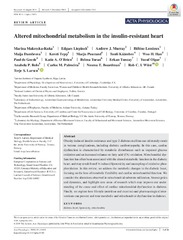Blar i forfatter "Boardman, Neoma Tove"
-
3-Weeks of Exercise Training Increases Ischemic-Tolerance in Hearts From High-Fat Diet Fed Mice
Boardman, Neoma Tove; Rossvoll, Line; Lund, Jim; Hafstad, Anne Dragøy; Aasum, Ellen (Journal article; Tidsskriftartikkel; Peer reviewed, 2019-10-02)Physical activity is an efficient strategy to delay development of obesity and insulin resistance, and thus the progression of obesity/diabetes-related cardiomyopathy. In support of this, experimental studies using animal models of obesity show that chronic exercise prevents the development of obesity-induced cardiac dysfunction (cardiomyopathy). Whether exercise also improves the tolerance to ... -
Altered mitochondrial metabolism in the insulin-resistant heart
Makrecka-Kuka, Marina; Liepinsh, Edgars; Murray, Andrew J.; Lemieux, Hélène; Dambrova, Maija; Tepp, Kersti; Puurand, Marju; Käämbre, Tuuli; Han, Woo H.; de Goede, Paul; O'Brien, Katie A.; Turan, Belma; Tuncay, Erkan; Olgar, Yusuf; Rolo, Anabela P.; Palmeira, Carlos M.; Boardman, Neoma Tove; Wüst, Rob C.I.; Larsen, Terje (Journal article; Tidsskriftartikkel; Peer reviewed, 2019-12-16)Obesity‐induced insulin resistance and type 2 diabetes mellitus can ultimately result in various complications, including diabetic cardiomyopathy. In this case, cardiac dysfunction is characterized by metabolic disturbances such as impaired glucose oxidation and an increased reliance on fatty acid (FA) oxidation. Mitochondrial dysfunction has often been associated with the altered metabolic function ... -
Cardiometabolic adaptations to altered fuel supply, Ca2+ handling and exercise
Boardman, Neoma Tove (Doctoral thesis; Doktorgradsavhandling, 2011-05-06)The thesis consists of experimental studies elucidating the mechanisms that contribute to changes in cardiac efficiency by i) the increase in fatty acid supply to the heart (chronic and acute), ii) changes in cardiac calcium handling and iii) physical exercise. By measuring the heart's oxygen consumption for both mechanical and non-mechanical processes, we have shown for the first time, that oxygen-cost ... -
Diet-induced obese mouse hearts tolerate an acute high fatty acid exposure that also increases ischemic tolerance
Boardman, Neoma Tove; Pedersen, Tina Myhre; Rossvoll, Line; Hafstad, Anne Dragøy; Aasum, Ellen (Journal article; Tidsskriftartikkel; Peer reviewed, 2020-09-03)An ischemic insult is accompanied by an acute increase in circulating fatty acid (FA) levels, which can induce adverse changes related to cardiac metabolism/energetics. Although chronic hyperlipidemia contributes to the pathogenesis of obesity-/diabetes-related cardiomyopathy, it is unclear how these hearts are affected by an acute high FA-load. We hypothesize that adaptation to chronic FA exposure ... -
How Exercise May Amend Metabolic Disturbances in Diabetic Cardiomyopathy
Hafstad, Anne Dragøy; Boardman, Neoma Tove; Aasum, Ellen (Journal article; Tidsskriftartikkel; Peer reviewed, 2015-04-28)Significance: Over-nutrition and sedentary lifestyle has led to a worldwide increase in obesity, insulin resistance, and type 2 diabetes (T2D) associated with an increased risk of development of cardiovascular disorders. Diabetic cardiomyopathy, independent of hypertension or coronary disease, is induced by a range of systemic changes and may through multiple processes result in functional and ... -
Human concentrations of uric acid scavenges adaptive and maladaptive ROS in isolated rat hearts subjected to ischemic stress
Boardman, Neoma Tove; Falck, Aleksander Tank; Lund, Trine; Chu, X; Martin, Armas Maria Montserrat; Norvik, Jon Viljar; Jenssen, Trond Geir; Ytrehus, Kirsti (Journal article; Tidsskriftartikkel; Peer reviewed, 2019-09-14)Uric acid is a purine degradation product but also an important antioxidant and ROS scavenger. Experimental settings that mimic myocardial ischemia-reperfusion have not included uric acid despite that it is always present in human extracellular fluid and plasma. We hypothesized that uric acid has an important role in myocardial ROS scavenging. Here, we tested the cardiac response to uric acid on ... -
Impaired left ventricular mechanical and energetic function in mice after cardiomyocyte-specific excision of Serca2
Boardman, Neoma Tove; Aronsen, J. M.; Louch, William Edward; Sjaastad, Ivar; Willoch, Frode; Christensen, Geir Arve; Sejersted, Ole M; Aasum, Ellen (Journal article; Tidsskriftartikkel; Peer reviewed, 2014-01-31)Sarco(endo)plasmic reticulum Ca2+-ATPase (SERCA)2 transports Ca2+ from the cytosol into the sarcoplasmic reticulum of cardiomyocytes and is essential for maintaining myocardial Ca2+ handling and thus the mechanical function of the heart. SERCA2 is a major ATP consumer in excitation-contraction coupling but is regarded to contribute to energetically efficient Ca2+ handling in the cardiomyocyte. ... -
Intra-cellular to inter-organ mitochondrial communication in striated muscle in health and disease
Boardman, Neoma Tove; Wüst, Rob C.I. (Journal article; Tidsskriftartikkel; Peer reviewed, 2023-02-02)Mitochondria sense both biochemical and energetic input in addition to communicating signals regarding the energetic state of the cell. Increasingly, these signaling organelles are recognized as key for regulating different cell functions. This review summarizes recent advances in mitochondrial communication in striated muscle, with specific focus on the processes by which mitochondria communicate ... -
NADPH oxidase 2 mediates myocardial oxygen wasting in obesity
Hafstad, Anne Dragøy; Hansen, Synne Simonsen; Lund, Jim; Santos, Celio X.C.; Boardman, Neoma Tove; Shah, Ajay M.; Aasum, Ellen (Journal article; Tidsskriftartikkel; Peer reviewed, 2020-02-19)Obesity and diabetes are independent risk factors for cardiovascular diseases, and they are associated with the development of a specific cardiomyopathy with elevated myocardial oxygen consumption (MVO<sub>2</sub>) and impaired cardiac efficiency. Although the pathophysiology of this cardiomyopathy is multifactorial and complex, reactive oxygen species (ROS) may play an important role. One of the ... -
Overexpression of NOX2 Exacerbates AngII‐Mediated Cardiac Dysfunction and Metabolic Remodelling
Hansen, Synne; Pedersen, Tina Myhre; Marin, Julie; Boardman, Neoma Tove; Shah, Ajay M.; Aasum, Ellen; Hafstad, Anne Dragøy (Journal article; Tidsskriftartikkel; Peer reviewed, 2022-01-10)The present study aimed to examine the effects of low doses of angiotensin II (AngII) on cardiac function, myocardial substrate utilization, energetics, and mitochondrial function in C57Bl/6J mice and in a transgenic mouse model with cardiomyocyte specific upregulation of NOX2 (csNOX2 TG). Mice were treated with saline (sham), 50 or 400 ng/kg/min of AngII (AngII50 and AngII400) for two weeks. In ...


 English
English norsk
norsk








